A Comprehensive Analysis: Beethoven's Symphony No. 5, Op. 67
VerifiedAdded on 2023/05/30
|5
|927
|277
Essay
AI Summary
This essay provides an analysis of Ludwig van Beethoven's Symphony No. 5 in C Minor, Op. 67, a renowned classical composition. It explores the symphony's four movements, detailing their structure, dynamics, and intended effect. The analysis covers the iconic four-note motif, the lyrical second movement, the ternary scherzo, and the exhilarating finale. Furthermore, the essay delves into Beethoven's biography, the symphony's developmental background, and the composer's use of various instruments. The author reflects on the symphony's enduring impact and personal significance, highlighting its importance in classical music history. This comprehensive overview emphasizes the symphony's dark themes and melodious overtunes, solidifying its place as an exemplary piece of musical composition.
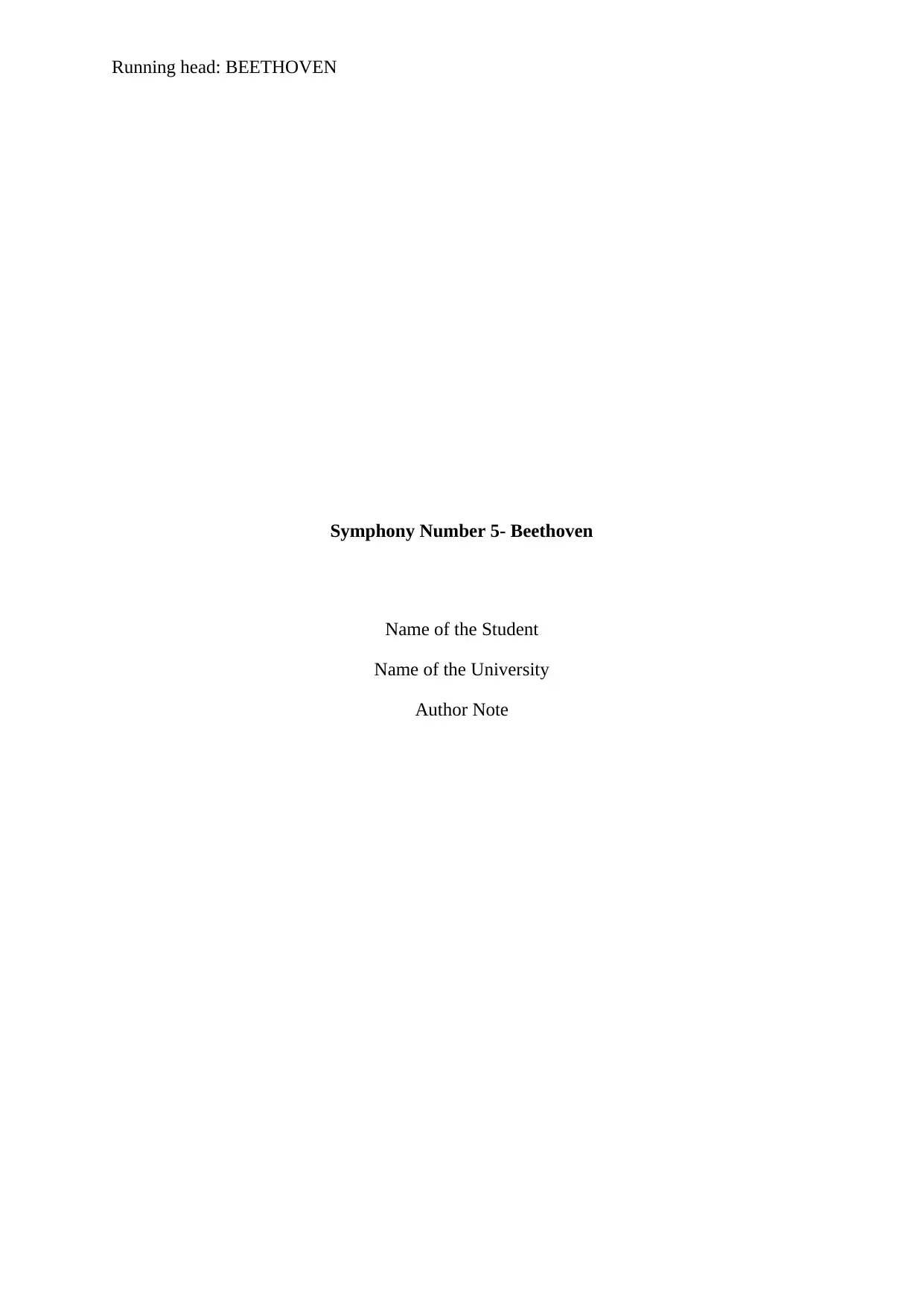
Running head: BEETHOVEN
Symphony Number 5- Beethoven
Name of the Student
Name of the University
Author Note
Symphony Number 5- Beethoven
Name of the Student
Name of the University
Author Note
Paraphrase This Document
Need a fresh take? Get an instant paraphrase of this document with our AI Paraphraser
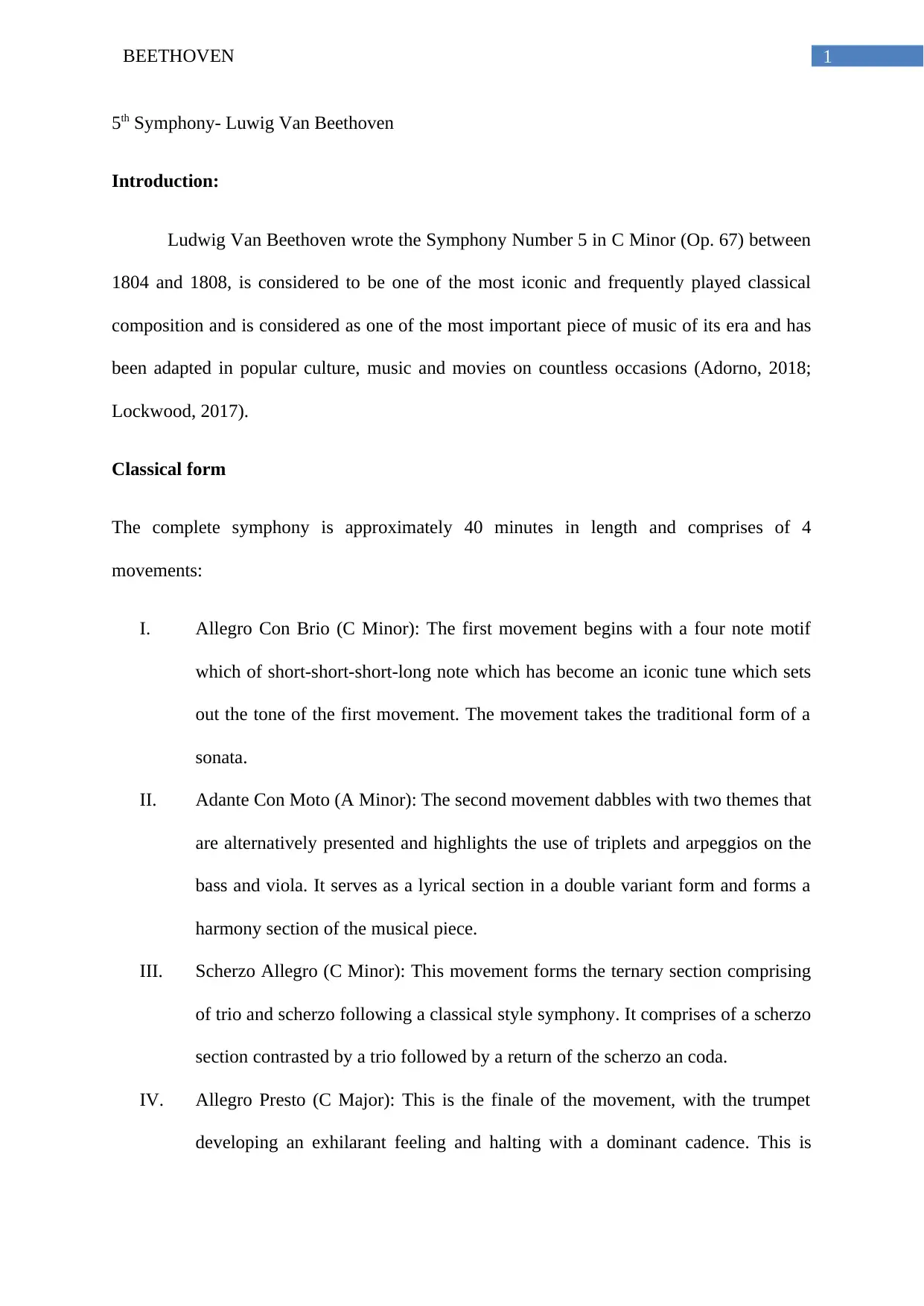
1BEETHOVEN
5th Symphony- Luwig Van Beethoven
Introduction:
Ludwig Van Beethoven wrote the Symphony Number 5 in C Minor (Op. 67) between
1804 and 1808, is considered to be one of the most iconic and frequently played classical
composition and is considered as one of the most important piece of music of its era and has
been adapted in popular culture, music and movies on countless occasions (Adorno, 2018;
Lockwood, 2017).
Classical form
The complete symphony is approximately 40 minutes in length and comprises of 4
movements:
I. Allegro Con Brio (C Minor): The first movement begins with a four note motif
which of short-short-short-long note which has become an iconic tune which sets
out the tone of the first movement. The movement takes the traditional form of a
sonata.
II. Adante Con Moto (A Minor): The second movement dabbles with two themes that
are alternatively presented and highlights the use of triplets and arpeggios on the
bass and viola. It serves as a lyrical section in a double variant form and forms a
harmony section of the musical piece.
III. Scherzo Allegro (C Minor): This movement forms the ternary section comprising
of trio and scherzo following a classical style symphony. It comprises of a scherzo
section contrasted by a trio followed by a return of the scherzo an coda.
IV. Allegro Presto (C Major): This is the finale of the movement, with the trumpet
developing an exhilarant feeling and halting with a dominant cadence. This is
5th Symphony- Luwig Van Beethoven
Introduction:
Ludwig Van Beethoven wrote the Symphony Number 5 in C Minor (Op. 67) between
1804 and 1808, is considered to be one of the most iconic and frequently played classical
composition and is considered as one of the most important piece of music of its era and has
been adapted in popular culture, music and movies on countless occasions (Adorno, 2018;
Lockwood, 2017).
Classical form
The complete symphony is approximately 40 minutes in length and comprises of 4
movements:
I. Allegro Con Brio (C Minor): The first movement begins with a four note motif
which of short-short-short-long note which has become an iconic tune which sets
out the tone of the first movement. The movement takes the traditional form of a
sonata.
II. Adante Con Moto (A Minor): The second movement dabbles with two themes that
are alternatively presented and highlights the use of triplets and arpeggios on the
bass and viola. It serves as a lyrical section in a double variant form and forms a
harmony section of the musical piece.
III. Scherzo Allegro (C Minor): This movement forms the ternary section comprising
of trio and scherzo following a classical style symphony. It comprises of a scherzo
section contrasted by a trio followed by a return of the scherzo an coda.
IV. Allegro Presto (C Major): This is the finale of the movement, with the trumpet
developing an exhilarant feeling and halting with a dominant cadence. This is
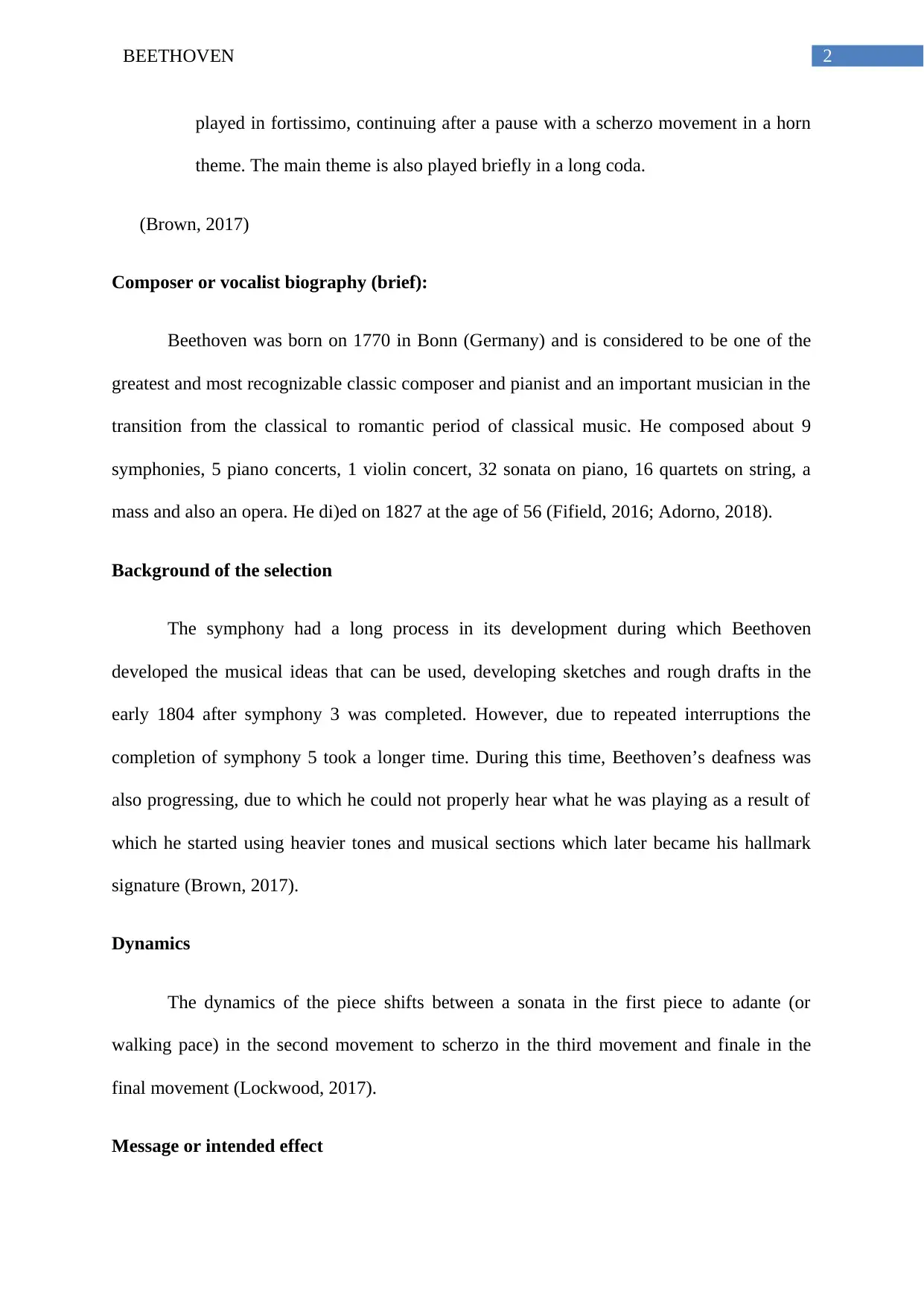
2BEETHOVEN
played in fortissimo, continuing after a pause with a scherzo movement in a horn
theme. The main theme is also played briefly in a long coda.
(Brown, 2017)
Composer or vocalist biography (brief):
Beethoven was born on 1770 in Bonn (Germany) and is considered to be one of the
greatest and most recognizable classic composer and pianist and an important musician in the
transition from the classical to romantic period of classical music. He composed about 9
symphonies, 5 piano concerts, 1 violin concert, 32 sonata on piano, 16 quartets on string, a
mass and also an opera. He di)ed on 1827 at the age of 56 (Fifield, 2016; Adorno, 2018).
Background of the selection
The symphony had a long process in its development during which Beethoven
developed the musical ideas that can be used, developing sketches and rough drafts in the
early 1804 after symphony 3 was completed. However, due to repeated interruptions the
completion of symphony 5 took a longer time. During this time, Beethoven’s deafness was
also progressing, due to which he could not properly hear what he was playing as a result of
which he started using heavier tones and musical sections which later became his hallmark
signature (Brown, 2017).
Dynamics
The dynamics of the piece shifts between a sonata in the first piece to adante (or
walking pace) in the second movement to scherzo in the third movement and finale in the
final movement (Lockwood, 2017).
Message or intended effect
played in fortissimo, continuing after a pause with a scherzo movement in a horn
theme. The main theme is also played briefly in a long coda.
(Brown, 2017)
Composer or vocalist biography (brief):
Beethoven was born on 1770 in Bonn (Germany) and is considered to be one of the
greatest and most recognizable classic composer and pianist and an important musician in the
transition from the classical to romantic period of classical music. He composed about 9
symphonies, 5 piano concerts, 1 violin concert, 32 sonata on piano, 16 quartets on string, a
mass and also an opera. He di)ed on 1827 at the age of 56 (Fifield, 2016; Adorno, 2018).
Background of the selection
The symphony had a long process in its development during which Beethoven
developed the musical ideas that can be used, developing sketches and rough drafts in the
early 1804 after symphony 3 was completed. However, due to repeated interruptions the
completion of symphony 5 took a longer time. During this time, Beethoven’s deafness was
also progressing, due to which he could not properly hear what he was playing as a result of
which he started using heavier tones and musical sections which later became his hallmark
signature (Brown, 2017).
Dynamics
The dynamics of the piece shifts between a sonata in the first piece to adante (or
walking pace) in the second movement to scherzo in the third movement and finale in the
final movement (Lockwood, 2017).
Message or intended effect
⊘ This is a preview!⊘
Do you want full access?
Subscribe today to unlock all pages.

Trusted by 1+ million students worldwide
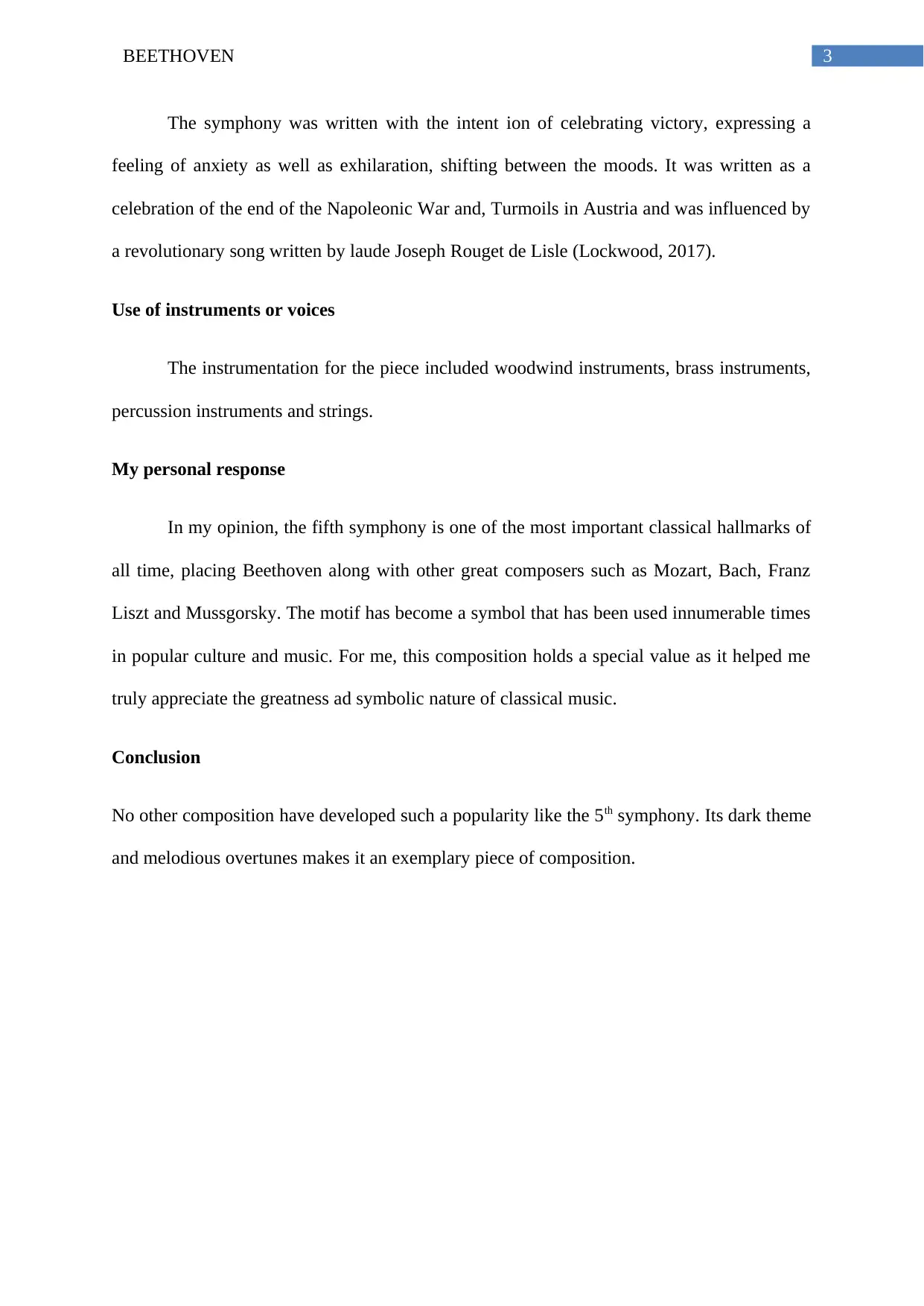
3BEETHOVEN
The symphony was written with the intent ion of celebrating victory, expressing a
feeling of anxiety as well as exhilaration, shifting between the moods. It was written as a
celebration of the end of the Napoleonic War and, Turmoils in Austria and was influenced by
a revolutionary song written by laude Joseph Rouget de Lisle (Lockwood, 2017).
Use of instruments or voices
The instrumentation for the piece included woodwind instruments, brass instruments,
percussion instruments and strings.
My personal response
In my opinion, the fifth symphony is one of the most important classical hallmarks of
all time, placing Beethoven along with other great composers such as Mozart, Bach, Franz
Liszt and Mussgorsky. The motif has become a symbol that has been used innumerable times
in popular culture and music. For me, this composition holds a special value as it helped me
truly appreciate the greatness ad symbolic nature of classical music.
Conclusion
No other composition have developed such a popularity like the 5th symphony. Its dark theme
and melodious overtunes makes it an exemplary piece of composition.
The symphony was written with the intent ion of celebrating victory, expressing a
feeling of anxiety as well as exhilaration, shifting between the moods. It was written as a
celebration of the end of the Napoleonic War and, Turmoils in Austria and was influenced by
a revolutionary song written by laude Joseph Rouget de Lisle (Lockwood, 2017).
Use of instruments or voices
The instrumentation for the piece included woodwind instruments, brass instruments,
percussion instruments and strings.
My personal response
In my opinion, the fifth symphony is one of the most important classical hallmarks of
all time, placing Beethoven along with other great composers such as Mozart, Bach, Franz
Liszt and Mussgorsky. The motif has become a symbol that has been used innumerable times
in popular culture and music. For me, this composition holds a special value as it helped me
truly appreciate the greatness ad symbolic nature of classical music.
Conclusion
No other composition have developed such a popularity like the 5th symphony. Its dark theme
and melodious overtunes makes it an exemplary piece of composition.
Paraphrase This Document
Need a fresh take? Get an instant paraphrase of this document with our AI Paraphraser
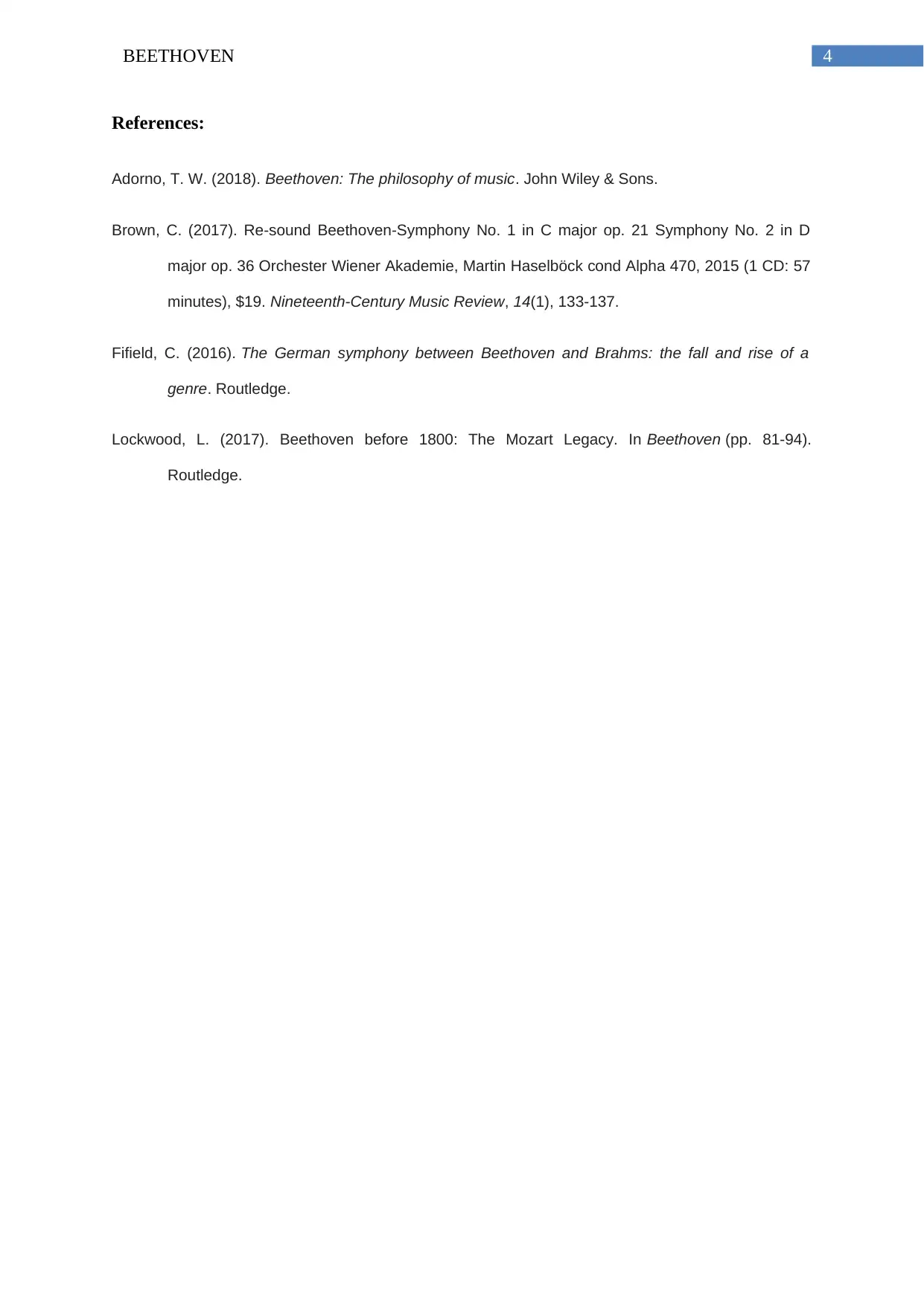
4BEETHOVEN
References:
Adorno, T. W. (2018). Beethoven: The philosophy of music. John Wiley & Sons.
Brown, C. (2017). Re-sound Beethoven-Symphony No. 1 in C major op. 21 Symphony No. 2 in D
major op. 36 Orchester Wiener Akademie, Martin Haselböck cond Alpha 470, 2015 (1 CD: 57
minutes), $19. Nineteenth-Century Music Review, 14(1), 133-137.
Fifield, C. (2016). The German symphony between Beethoven and Brahms: the fall and rise of a
genre. Routledge.
Lockwood, L. (2017). Beethoven before 1800: The Mozart Legacy. In Beethoven (pp. 81-94).
Routledge.
References:
Adorno, T. W. (2018). Beethoven: The philosophy of music. John Wiley & Sons.
Brown, C. (2017). Re-sound Beethoven-Symphony No. 1 in C major op. 21 Symphony No. 2 in D
major op. 36 Orchester Wiener Akademie, Martin Haselböck cond Alpha 470, 2015 (1 CD: 57
minutes), $19. Nineteenth-Century Music Review, 14(1), 133-137.
Fifield, C. (2016). The German symphony between Beethoven and Brahms: the fall and rise of a
genre. Routledge.
Lockwood, L. (2017). Beethoven before 1800: The Mozart Legacy. In Beethoven (pp. 81-94).
Routledge.
1 out of 5
Your All-in-One AI-Powered Toolkit for Academic Success.
+13062052269
info@desklib.com
Available 24*7 on WhatsApp / Email
![[object Object]](/_next/static/media/star-bottom.7253800d.svg)
Unlock your academic potential
Copyright © 2020–2025 A2Z Services. All Rights Reserved. Developed and managed by ZUCOL.
